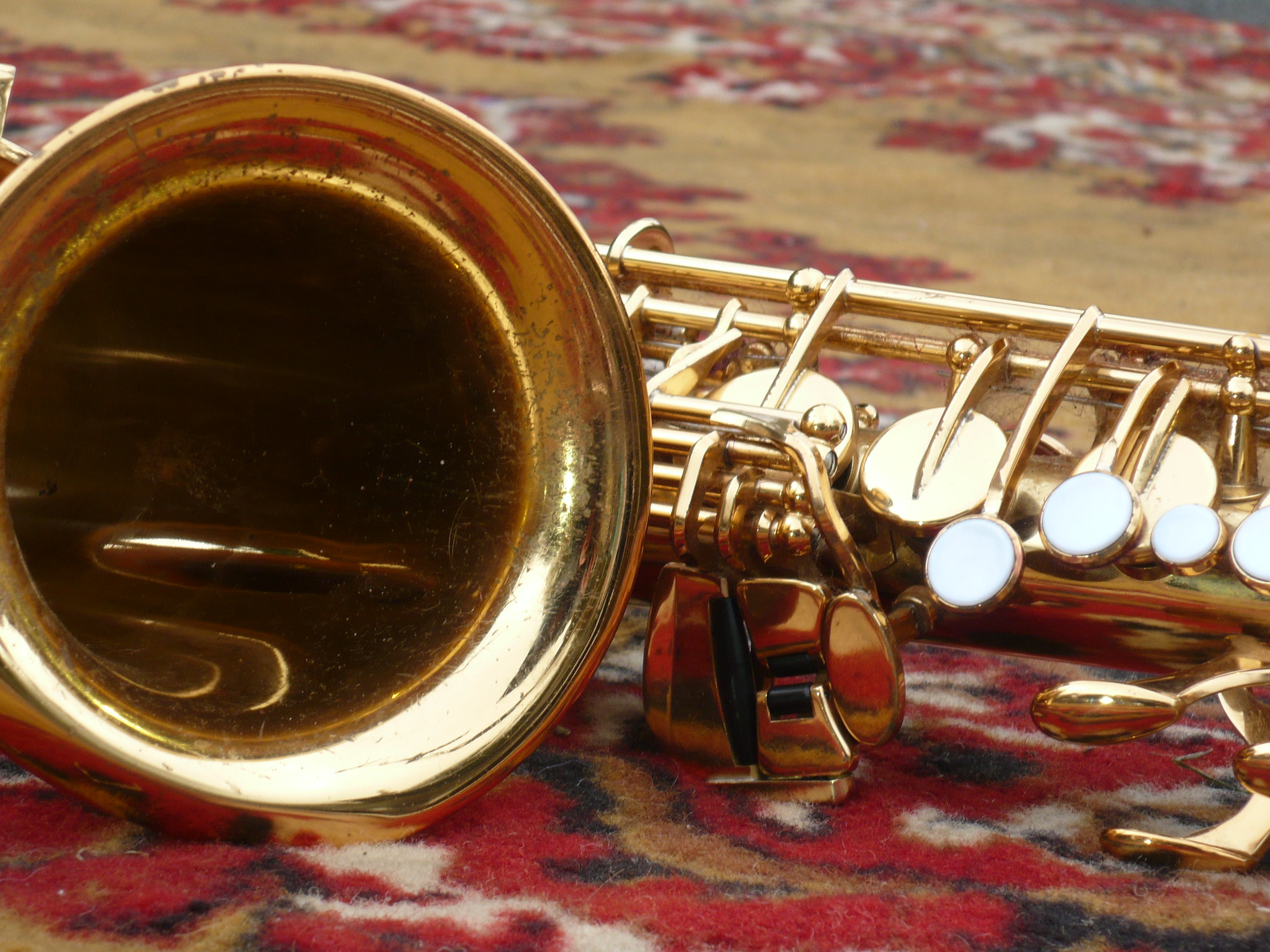Prior to attempting notes in the altissimo range, saxophone players need to have an established foundation in other fundamentals. Students should have a well-developed saxophone embouchure, good control of the basic two and a half octave range of the saxophone, and a good grasp of pitch perception. It would be extremely helpful for a student to work with a private saxophone teacher when learning altissimo.
What is the Altissimo Range on Saxophone?
The altissimo range on saxophone is defined as any notes above high F (fourth space above the treble staff). The vast majority of professional model saxophones now have a high F# key. Because of this, I typically think of altissimo beginning on high G.
Warm-up
One should not attempt to work on altissimo until completely warmed-up. Your body needs to be ready to practice before you even take your saxophone out of the case. Everyone has a different warm-up routine that works for them. These are some suggestions of things that I find work well.
A quick disclaimer, I am not a medical professional and therefore am not an authority, in any way, on how exercise and stretching can affect your health. Remember, the recommendations below are only suggestions. If something feels uncomfortable, don’t do it!
Being Mentally Ready, Breathing, and Stretching
First ask yourself, “Am I mentally focused enough to begin practicing?” If the answer to that question is, “No,” then you may want to come back to practicing a bit later. If your brain is thinking about all of the other things you have to do, what to make for dinner, and how you’re going to get it all done, consider accomplishing some of those things first. Then come back to practicing with a clearer mind.
Once your mind is focused on practicing, sit comfortably in a chair (or try to stand in a relaxed manner, depending on if you stand or sit to practice) and do a few breathing exercises to center yourself. First tense your entire body, from your toes up to your head. Then slowly, starting with your toes and working upward, relax and release the tension from every part of your body.
Now take a few deep breaths, breathing in through your nose and out through your mouth. Place your hand on your stomach to feel yourself expand on the inhale. Be sure your shoulders stay relaxed. It’s sometimes helpful to close your eyes while you practice this breathing exercise. If you’re familiar with the three-part breath in yoga, that works very well for this exercise!
Now that you’ve relaxed a bit, you’re ready to begin stretching. You wouldn’t go for a run without first stretching, and the same idea applies to playing an instrument. Some stretches that work for many people are neck rolls, neck bends, shoulder shrugs, exaggerated smiles (to loosen up your facial muscles for your embouchure), and finger stretches. Again, everyone is different, so you need to find the stretching exercises that work the best for you.
Scales, Long Tone, and Intonation Exercises
Now you’re ready to take your saxophone out of its case! If you’re thinking about learning altissimo, then you probably already have an established routine that you play as a warm-up. Most likely, it includes playing scales and thirds and doing some type of long tone and intonation exercises.
As boring as it is to practice minor (all three versions) and major scales, and thirds, they are a great warm-up. You have to practice them anyway, so they might as well be a part of your warm-up routine! You can always put scale names on slips of paper in a cup, and draw names. This will discourage you from always practicing scales in the same order. You can also practice scales slurred, or with a variety of tonguing patterns, and at various speeds.
Long tones are definitely not my favorite thing to practice. They are very important, however, in helping a player improve tone, vibrato, and intonation. Just be sure you are actively listening to your sound during long tone exercises. If you are not, nothing will improve and you’ve just wasted part of your practice time.
Intonation exercises can be part of long tone exercises, as was previously mentioned, or they can be a separate exercise. Many people find it helpful to do pitch-matching exercises on their mouthpiece, or mouthpiece and neck. You can even do mouthpiece glissandi, arpeggios, and scales! This will not only help with intonation but also with various other aspects of playing in the altissimo range.
So Now You’re Done Warming-Up…Let’s Talk About The Overtone Series
The practice of the overtone series is a good first step in learning how to play in the altissimo register. To begin with, play a low Bb and then add the octave key. You should hear third line Bb. After this, adjust your embouchure a bit (more on that in the next section), but don’t change fingerings, to play fifth line F. After practicing, you will be able to play all of the harmonics, as illustrated below. After mastering the overtone series on low Bb, you can then progress to low B and low C. Their overtone series is also illustrated below.

Please remember that this is not going to happen after a day or two of practicing! It will take time, so be patient. Eventually, you will be able to finger a low Bb with the octave key, and play a bugle call without ever changing the fingering!
Every person is different, so there is a degree of trial and error in figuring out what works the best for you with overtones. Just remember that the answer to playing higher is never, ever to bite harder on the mouthpiece.
Recommended Techniques for Finding Success with Altissimo
There are certain techniques that are highly recommended when producing notes in the altissimo register. I have found Beginning Studies in the Altissimo Register, by Rosemary Lang, is very helpful. The book begins with suggested techniques, progresses to the overtone series, and then moves through exercises (with fingerings) to help one learn each altissimo note.
As with every technique, each saxophone has its own unique characteristics when it comes to playing in the altissimo register. A fingering or embouchure that works on alto, may be different when playing altissimo on soprano or tenor saxophones.
Here is a list of techniques that work for many saxophonists who are learning altissimo:
- Be sure to have a firm, but not tight embouchure - As I mentioned previously, nothing good can come from biting down on your mouthpiece in order to squeeze out a note. You might get a note to come out, but it won’t be pretty or in tune! Remember, firming up the muscles around your mouth is quite different than biting down on your mouthpiece.
- Use a steady airstream, with fast-moving air.
- Arch your tongue toward the roof of your mouth.
- Raise your soft palette. If you’re not sure how to do this, say “oh” with a quick intake of air, as if something has just surprised you. You should feel cool air hitting your soft palette, as it raises.
- At first when learning altissimo, only use breath attacks. Using your tongue to start altissimo notes, will come with time. If you try to use your tongue immediately, it will only lead to frustration!
Suggested Books for Learning Altissimo
Beginning Studies in the Altissimo Register by Rosemary Lang - This is the book that I recommend the most to students. There is information on the overtone series, and each altissimo fingering has two pages of exercises.
Altissimo Repertoire Studies by Jamal Rossi - Includes altissimo passages from standard saxophone literature.
Trial and Error, Practice and Patience
As you are learning altissimo, remember that all of the techniques listed above, may not work for you. Ultimately, you may find one or two that work. Because everyone is different, nothing about playing a musical instrument is an exact science. As teachers, we can offer suggestions of techniques, but the student, through trial and error needs to find the correct air support, embouchure, and tongue and soft palette placement.
Playing in the altissimo register is not going to happen immediately. One needs to be patient, spend time with warm-ups, and practice carefully in order to find success in the altissimo register. It really will happen, and it will even sound good, too! You just need to stick with it and keep trying!
Special thanks to Jeremy Corcoran for the altissimo practice scales image!






